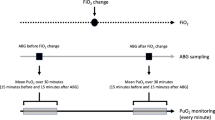Abstract
Continuous non-invasive monitoring of conjunctival oxygen tension (PcjO2) versus ‘conventional’ invasive hemodynamic and oxygen transport variables was evaluated in a porcine model of septic shock induced by a continuous i.v. infusion of E.coli endotoxin over 2 hours. Seventeen pigs under ketamine anesthesia and breathing air spontaneously were investigated. PcjO2, which reflects local oxygen tension at tissue level, correlated significantly at baseline and throughout the septic course with mixed venous oxygen saturation and oxygen utilization coefficient. All these correlations were significant at the 1% level. The corresponding correlations between PcjO2 and cardiac output were significant at the 5% level. A finding of great importance was that changes in PcjO2 preceded major changes in the intermittently measured physiological variables such as SvO2 and cardiac output.
We conclude that PcjO2 monitoring is a valuable non-invasive method and which can provide a continuous assessment of the hemodynamic and oxygenation status in experimental septic shock.
Similar content being viewed by others
References
Bland R, Shoemaker WC, Shabot MM. Physiologic monitoring goals for the critically ill patient. Surg Gynecol Obstet 1978; 147: 833–41.
Shoemaker WC. Circulatory mechanisms of shock and their mediators. Crit Care Med 1987; 15: 787–94.
Fatt I, Deutsch TA. The relation of conjunctival PO2 to capillary bed PO2. Crit Care Med 1983; 11: 445–8.
Abraham E, Oye RK, Smith M. Detection of blood volume deficits through conjunctival oxygen tension monitoring. Crit Care Med 1984; 12: 931–4.
Shoemaker WC et al. Effect of hemorrhagic shock on conjunctival and nasocultaneous oxygen tensions in relation to hemodynamic and oxygen transport changes. Crit Care Med 1984; 12: 949–52.
Smith M, Abraham E. Conjunctival oxygen tension during hemorrhage. J Trauma 1986; 26: 217–24.
Kram HB, Shoemaker WC. Conjunctival oxygen tension in experimental and clinical conditions: Tissue oxygen metabolism in hyperoxia, hypoxia and hemorrhagic shock. Acute Care 1985; 11: 89–99.
Lewis FR, Elings VB, Hill SL, et al. The measurement of extravascular lung water by thermal-green dye indicator dilution. Ann NY Acad Sci 1982; 384: 394–410.
Siegel S. Non-parametric statistics. McGraw-Hill: New York, Toronto, London, 1956.
Bland RD, Shoemaker WC. Common physiologic patterns in general surgical patients: Hemodynamic and oxygen transport changes during and after operations in patients with and without associated medical problems. Surg Clin N Amer 1985; 65: 793–809.
Shoemaker WC, Bland RD, Appel PL. Therapy of critically ill postoperative patients based on outcome prediction and prospective clinical trials. Surg Clin N Amer 1985; 65: 811–33.
Kram HB, Fukanaga A, Chen B et al. Method of measuring organ surface oxygen tension in experimental and clinical conditions. Crit Care Med 1984; 12: 298–304.
Lang CH, Bagby GJ, Bornside GH, Vial LJ, Spitzer JJ. Sustained hypermetabolic sepsis in rats: Characterization of the model. J Surg Res 1983; 35: 201–10.
Borg T, Alvfors A, Gerdin B et al. A porcine model of early adult respiratory distress syndrome induced by endotoxaemia. Acta Anaesthesiol Scand 1985; 29: 814–30.
Modig J, Samuelsson T, Sandin R. Volume substitution and treatment with prostaglandin E1 in a porcine model of endotoxaemia-induced pulmonary and cardiovascular failure. Acta Chir Scand 1987; 153: 165–70.
Modig J. Comparison of effects of dextran 70 and Ringer's acetate on pulmonary function, hemodynamics and survival in experimental septic shock. Crit Care Med, 1988; 16: 266–71.
Modig J, Sandin R. Haematological, physiological and survival data in a porcine model of adult respiratory distress syndrome induced by endotoxaemia. Effects of treatment with N-acetylcysteine. Acta Chir Scand, 1988; 154: 169–77.
Author information
Authors and Affiliations
Rights and permissions
About this article
Cite this article
van der Linden, J., Modig, J. & Wiklund, L. Conjunctival oxygen tension monitoring in experimental septic shock. J Clin Monit Comput 6, 37–43 (1989). https://doi.org/10.1007/BF01723371
Accepted:
Issue Date:
DOI: https://doi.org/10.1007/BF01723371




